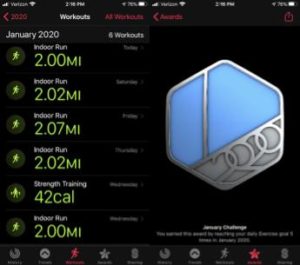My Big Goals for 2020
In setting these super big goals for the year, I committed to weekly pulse checks to measure my progress. With no quite one week under my belt, here’s where I stand. How are your goals going? What are you doing to stay motivated?
01: Get 6 – 7 Hours of Sleep Each Night
Since I am still on our holiday break from school, this has not been a problem. That said, this week will be my first ‘test’ – new habits are coming!
02: Save Money
One debt has been paid off, allowing me to rollover that cash into a second debt. Fingers are crossed that my HVAC unit continues to hold out – as replacing one debt with a different one is not on my list! When I was running on Thursday morning, it did not sound happy 🙁
03: Learn Calligraphy
I’m setting up my iPad today. I promise. No really. I am.
04: Purge 1000 items {Status: 62/2000}
In putting away Christmas decorations and tidying up after the holidays, I have been purging without abandon. So, I an reporting lots of success in this department this week by donating high school science books, clothes, and holiday decorations.
This week, the following items from my home found new homes:
Clothes (26), Books (8), Decorative Boxes (3), Candles (1), Holiday decorations (3), Beauty supplies (20), and Cleaning supplies (1)
Current Status: 62/1000 items out of my house!
05: Organize the Attic
Slight – very slight – progress in this area this week. I purged our Christmas decorations as they were packed to go back in the attic. Plus, we intentionally placed the holiday decorations together in one spot in the attic. This will give us a place to start when I dive deeply into this project.
06: Read 100 Books, including ALL of the DBC books. {Status: 02/100}
Some fun, nonfiction reading during the holiday break towards my 100 book goal.
(1) Don’t Lie to Me | Willow Rose {Fun Read}
(2) The Last Thing She Ever Did | Gregg Olson {Fun Read}
In Progress
(3) The Sound of Rain | Gregg Olson {Fun Read}
(4) Tiny Habits | Fogg {Personal Growth}
(5) Radical Candor | Scott {Professional Growth}
I am intentionally taking my Personal and Professional growth books slow,y so I can savor, learn, and integrate these reads into my life.
07: Try 52 New Recipes {Status: 01/52}
What do you do when your sister gifts you with three very ripe avocados?
Avocado Pasta. Seriously…this was a winner! Loved it! Tossed with fresh seafood that we had on hand. It was a nice break from our traditional holiday food, hearty, and healthy.
08: Get in Shape
This week, I maintained a 5 day run streak, logging 2 miles each day. I also carefully watched nutrition – cutting back significantly on Diet Coke (Yes, I know how terrible it is) and acknowledging my sugar addiction. See #OneMonthGoals below for details!
09: #OneMonthGoals with Michael Matera
Last year, I joined Michael Matera on his #OneMonthGoals journey. I ran every single day for a month – and it was glorious. This year, I am committed to selecting (and sticking with) one new goal each month, which I will document here.
January 2020: Run daily. 31 day running streak, here I come.
January Day 5 – logging 2 miles each day. Each time I lace up my sneakers, I run a little more and walk a little faster. And, I’ve already earned by January Apple Watch badge. I’m such a sucker for Badges!

10: Write/Send 52 notes/cards {Status: 0/52}
I found my stationary… so, I’ll work on that next week.
11: Redesign my sunroom
This begins with decluttering. See #04.
12: Do things that make me feel alive (One per month) {Status: 01/12}
Saying YES to adventures is something that I want to do more frequently. On Saturday night, we joined dear friends and their daughter – whose husband has just begun the next chapter in his career as a Chef at The Blue Point (Duck, NC). We have heard so many wonderful things about this restaurant, but we had never made time to visit. What a perfect time to go!
The Blue Point did not disappoint! From scrumptious appetizers of Warm Deviled Crab Dip, Hoisin Glazed Baby Back Ribs, and a seasonal charcuterie of duck, salmon, liver, and sweet potato bisuits, to a dinner of Pamlico Sound green tail shrimp ramen bowl, grilled bone-in pork chop over apple-cabbage slaw, and seared Outer Banks sea scallops over madras curry lentils, and wrapping up with Warm Southern Pecan Pie over Bourbon Ice Cream, Double Vanilla Bean Creme Brulee, and White Chocolate Ganashe Cake with Grand Marnier soaked raspberries, the food was decadent.
Without a doubt, we WILL return. Although, I doubt that I will ever see that many dishes cross the table during one meal… that was such a treat.
Secret Goals!
- Secret Goal #1: This resumes next week! Stay tuned
- Secret Goal #2: We’ve started this one… slowly but surely!
- Secret Goal #3
- Secret Goal #4
How are your goals going?
Cheers, Holly



